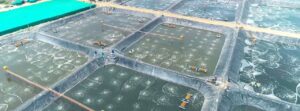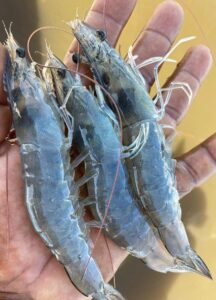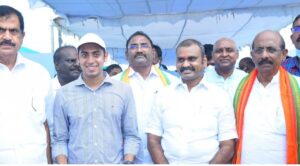In 2015, when computer science engineering graduate Nishanth Reddy took up shrimp farming from his father, he had no clue how to carry it forward. Today, this 27-year-old derives 30 times more production from his 5-hectare shrimp aquafarm located at Nellore in Andhra Pradesh by employing Biofloc technology.
“India is the second-largest exporter of shrimp in the world. But the pandemic and certain diseases which affect the species brought down our production. When I stepped into this field, many diseases were prevalent and I decided to study their root cause,” says Nishanth, owner of Sri Lakshmi Prasanna Aquaculture Pvt Ltd.
Tech-induced farming
Traditionally, shrimps are grown in water which is placed above the soil. Nishanth found that all diseases are caused by overexploited soil. The presence of ammonia and other chemicals pose as villains to the healthy growth of shrimps.
He thus introduced the HDPE (High-Density Polyethylene) geomembrane, which has chemical and ultraviolet resistance properties, to take the place of soil. Thereby, overexploitation of soil and diseases from it is tackled.
Biofloc technology is another effective method he applied which tremendously increased shrimp production. “Like any other living being, shrimps excrete the same quantity of feed given to them. Using this technology, the faecal matter is converted back to feed which is highly nutritious. Aggregates of bacteria, algae, and protozoa are held together in a matrix with organic matter to improve water quality and prevent diseases. It is an eco-friendly practice that reuses and reduces waste,” explains Nishanth.
He was introduced to this method through thorough research. He says that scientists of Israel carried out this technique and Nishanth madefarmers of Andhra necessary changes while employing it at his aquafarm. “It is for the first time that this approach is carried out in India,” he claims.

Biofloc technology helped this young farmer to yield 4-5 metric tonnes from one hectare per year. About 100 employees are working on this aquafarm. “I left my job and came into aquafarming just because of the social responsibility to continue my father’s business and sustain our employees. Most of them have been here for the past three decades,” says Nishanth.
“This method helps in drastically reducing the usage of water from hundreds of litres to 15-20 litres, which saves this natural resource,” he says.

Nishanth and his father Narendranath Reddy have a total area of 80 hectares as farmland. Five hectares are used for aquaculture and the rest for extensive farming. “It will take at least two years for us to develop the remaining area using a similar method. This technology requires a high investment of up to Rs 1.5 crore per hectare. But it is a highly profitable business and takes roughly two years to receive the maximum return on investment,” he adds.
In addition to the Biofloc technology, Nishanth’s farm is fully operated via his smartphone. He monitors the farm from a control room and has set up AI-based CCTV cameras around the ponds.
The aquafarm was visited by the Union Minister of State for Fisheries, Animal Husbandry and Dairy, Dr L Murugan last month, and he appreciated the youngster for his efforts.

Nishanth hopes to expand his farming and provide employment to more people. His innovation is undoubtedly a revolution in aquaculture which has enough potential to change the face of the Indian economy.
(Edited by Yoshita Rao)
No comments:
Post a Comment